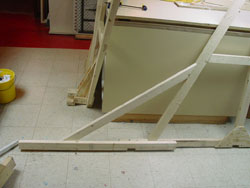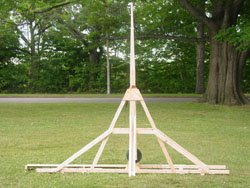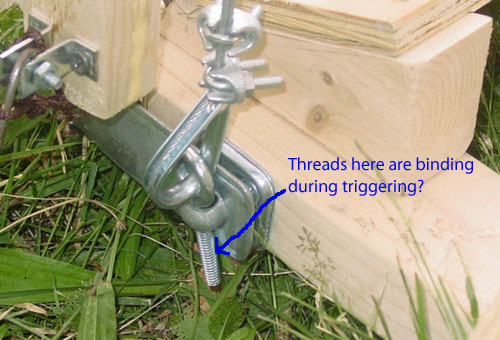Today Jeckyl and Hyde was taken out for some launching in King Arthur configuration. Chris and Jason were not around, but some of Matt's family members helped out, since Jeckyl and Hyde requires two people to operate. Testing, once again, was with a 50 pound counterweight and a standard baseball as the projectile. It was a beautiful day for launching weather-wise, but Jeckyl and Hyde was a bit cranky anyway. The first shot was not much of a shot. In fact, the secondary trigger failed to trigger completely until just after the counterweight smashed into the arm. Damage, however, was minimal as only the pin we used to hold the tip of the arm in the secondary trigger bent, and was fairly easily bent back into a usable position. No other damage was found.
One thing we had done since the last launch day was that frame extensions were thought about. We came pretty close to abandoning the frame until a way was devised to extend the frame while not taking up more storage room. These extensions were to be removable, and after some cutting of lumber and placing at various angles until it looked okay and then cutting that angle, the extensions looked like this:

Some way of attaching the angled part to the frame was still necessary, but that was a minor detail soon figured out and put on. Then three more extensions were made to the same dimensions. More bolts hold the two pieces for each extension to the frame. Fully assembled, Jeckyl and Hyde now looked like this from the side:

The best part was that the frame now did not rock one bit! Of course, lengthening it by five feet was bound to help that problem from back in March. But even with the first shot being essentially a dry fire, a similar situation to what flipped the trebuchet before, the frame did not rock much, just a tiny bit of lifting of one end of the frame.
The second shot was very nice, with the secondary triggering properly, albeit a bit early, and the sling firing the baseball downrange at roughly 80 miles per hour. Landing occurred 275 feet downrange, with a trajectory slightly above optimal, at about 60 degrees above the horizontal. The arm swung smoothly through the frame, until the counterweight traveled forward again, when its axle hit the front of the frame, sliding the entire frame forward a few inches. This caused no damage to the trebuchet, however, which was a good thing.
The third shot was very similar to the second, though the secondary triggered a bit later due to our lengthening the line a little. It was still way to early, but we still got a range of 285 feet out of the shot. Best of all, the arm and counterweight assembly never hit the frame, giving us a very nice and clean shot.
The last shot, however, resulted in a bit of a relapse for Jeckyl and Hyde. That is, the secondary failed to trigger, as it did for the first shot. Again, however, there appeared to be no damage to the machine aside from some parts of the secondary getting bent, which were quickly bent back into a rough semblance of their original form. We began to ready for another shot when it was discovered that the end of one side of the short arm extensions was split badly from the counterweight axle hole through the end of the arm. Obviously we could not fire with this crack unless we wished to risk entirely destroying the machine, so we packed up for the day and went home.
It is quite clear to us that we need to find out why the secondary trigger failed on half of our shots when it was not failing at all before. Also, we need to build a new arm before we can do any more firing, and that is the first priority, so that we can do several more launches this summer and fall. At the moment, our theory on the failing secondary is that the eyebolt that pulls out of the hasp is binding on the way out, causing it to come out too late.

The obvious solution is to make the smooth pin that we wanted initially, but could not find when building. The eyebolt was only used as a temporary measure to get the machine finished and firing, and we now need to upgrade.
As mentioned earlier, all shots launching a standard (5-ounce) baseball.
| Shot # | Counterweight (Pounds) | Sling Length | Distance (Feet) | Notes |
| 1 | 50 | 5' 8" | backwards | Secondary failed. |
| 2 | 50 | 5' 8" | 275 | Nice smooth shot, high launch angle, early secondary, bumped frame well after release. |
| 3 | 50 | 5' 8" | 285 | Very smooth shot, high launch angle, early secondary, no bumping. |
| 4 | 50 | 5' 8" | backwards | Secondary failed to trigger, cracked end of arm. |
There is video from today in the Jeckyl and Hyde Video Gallery.









